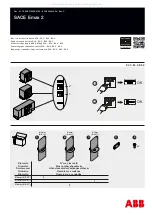
21
Since the striker pin of the undervoltage
release 3AX1103 is latched only when the
armature is energized, the undervoltage
release is provided with a screw (29.0), for
locking the striker pin (23.0) in the normal
position for adjusting purposes or for carrying
out trial operations during circuit breaker
servicing. Position A (locked) disables the
undervoltage release. Position B (unlocked) is
the normal operating position.
Capacitor trip device
The capacitor trip device is an auxiliary
tripping option providing a short-term means
of storing adequate electrical energy to
ensure circuit breaker tripping. If provided, a
capacitor trip device must be located in the
outdoor circuit breaker enclosure, as space is
not available inside the type 3AH35-SE
operator housing.
This device is applied in circuit breaker
installations lacking independent auxiliary
control power or station battery. In such
installations, control power is usually derived
from the primary source. In the event of a
primary ac source fault or disturbance the
capacitor trip device will provide short-term
tripping energy for circuit breaker opening
due to protective relay operation or operation
of a circuit breaker control switch.
The capacitor trip converts 120 or 240 Vac
control voltage to a dc full-wave voltage that
is used to charge a large capacitor to the peak
of the converted wave (refer to Figure 15:
Capacitor-trip device on page 20).
Shock absorber
Circuit breakers are equipped with a hydraulic
shock absorber (61.8) (refer to Figure 6:
Stored-energy operating mechanism (circuit
breaker shown in OPEN position) on page
12). The purpose of this shock absorber is to
limit overtravel and rebound of the vacuum
interrupter movable contacts during the
conclusion of an opening operation. The
shock absorber action affects only the end of
an opening operation.
Auxiliary switch (52a/b)
Figure 6: Stored-energy operating mechanism
(circuit breaker shown in OPEN position) on
page 12) shows the circuit breaker mounted
auxiliary switch (68.0). This switch provides
auxiliary contacts for control of circuit breaker
closing and opening functions. Contacts are
available for use in relaying and external logic
circuits. This switch is driven by linkage (68.1)
connected to the jack shaft (63.0). The
auxiliary switch contains both “b” (normally
closed) and “a” (normally open) contacts.
When the circuit breaker is open, the “b”
contacts are closed and the “a” contacts are
open.
Spring-charging motor (88)
Spring-charging motors (50.4) (refer to Figure
6: Stored-energy operating mechanism
(circuit breaker shown in OPEN position) on
page 12) are available for either ac or dc
operation. If operated with ac voltage, a
rectifier is installed in the circuit breaker.
Summary of Contents for 3AH35-SE Series
Page 46: ...46 Table 13 Remarks ...
Page 47: ...47 Table 13 Remarks continued ...






































